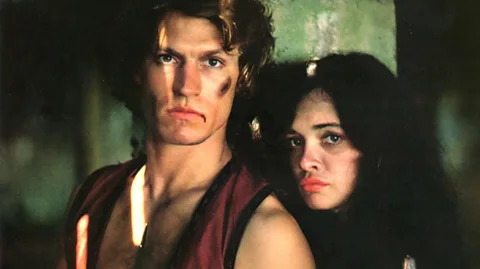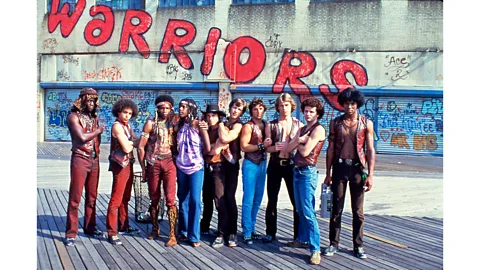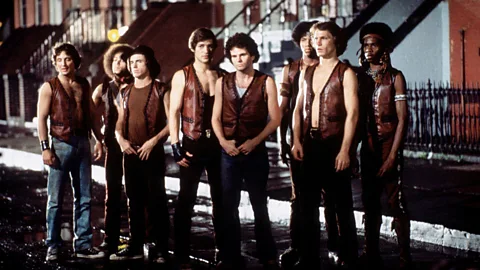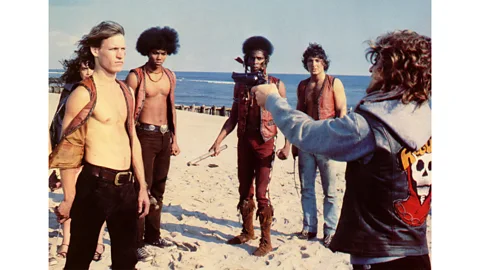The Warriors: The 1979 cult hit that shows an ultra-violent NY
 Alamy
AlamyReleased during a period when New York was "the poster child for disrepair and abandonment", dystopian film The Warriors came to appear more realistic than intended – 45 years on, it's now a cult classic.
The New York City of the late 1970s was in disarray.
Economic and political strife saw city workers laid off in their thousands. There was a huge movement of residents to the suburbs, which resulted in less tax revenue, and left New York on the brink of bankruptcy. There was constant crime, looting, and a sanitation strike that left huge piles of rubbish rotting on the streets.
"New York was a tough place to live at the time," says Elizabeth Currid-Halkett, a professor of public policy at the University of Southern California. "There was a large restructuring of the global economy, a decline in manufacturing in our cities. New York became the poster child for disrepair and abandonment."
 Alamy
AlamyThis was the environment that Walter Hill's The Warriors was released into on 9 February, 1979. Set in a dystopian version of New York that has eerie similarities to how it really was at the time, The Warriors revolves around the titular gang from Coney Island that attend a summit being held by Cyrus (Roger Hill) at the other end of the city in the Bronx.
When Cyrus is murdered at the event, The Warriors falsely become the prime suspects. They somehow have to make their way back through Manhattan and Brooklyn to the safety of Coney Island, all while avoiding the other New York gangs that are after revenge.
"The fact that New York was much tougher in the late 1970s gave the film a plausible backdrop as the city was dangerous for folks," adds Currid-Halkett. "Obviously that's not the case today, as New York is so much safer. You couldn't do it now. Just like you couldn't do Sex and the City in the 1970s."
 Alamy
AlamyThe Warriors' use of the city is all the more fascinating because Hill, who co-wrote the film with David Shaber as well as directing it, was about as far away from being a New Yorker as an American can get. Born and raised in Southern California, he was very much a "surfer dude," insists journalist Jason Bailey, who in 2021 wrote Fun City Cinema, a visual history of 100 years of filmmaking in New York City. "He couldn't make a realistic New York movie if he wanted to. Most of his early films are set in Los Angeles. They are very in tune with those streets. This is a completely different world."
Sol Yurick's 1965 novel, on which The Warriors is based, was set in New York so setting the adaptation there was a must. Hill was initially attracted to the material because of its similarities to the Ancient Greek poem Anabasis by Xenophon, which tells the story of a group of Greek mercenaries stuck deep behind enemy lines trying to get back to the Black Sea from Babylon.
An outsider's vision
But while there are a host of directors from New York – Martin Scorsese, John Cassavetes, Spike Lee, The Safdie Brothers to name a few – who have shot the city with an eye and meticulousness that has made the bustling metropolis pop for viewers across the world, there's also been plenty of outsiders who have brought the city to life in their own inimitable fashion, too.
"Some of the best New York movies are the ones that have been made by outsiders with an outsider's eye," explains Bailey. Examples include Midnight Cowboy and Marathon Man, both of which were directed by Britain's John Schlesinger, The French Connection by Chicago's William Friedkin, and Saturday Night Fever by British-born, Alabama-raised John Badham.
 Alamy
Alamy"A lot of times, that outsider eye, it sees things that a local filmmaker who's been around this environment their entire life might take for granted," adds Bailey. "With The Warriors, shooting in the night-time and the way he lit it, he created a spooky imagery. There's the way he uses the subway, too: he was able to play with the staging and composition and take advantage of it."
As one of The Warriors' location managers, alongside Alex Ho, David Streit was tasked with finding specific locations in Manhattan, Queens, and Brooklyn – a job he was very well suited to, as he was born and raised in the city and had previously worked as a taxi driver. "My job was to take the production into the most dangerous parts of New York and see if we could survive," recalls Streit. "My instinct was to go dark and dangerous. New York certainly had a lot of that at the time. It wasn't hard to find these locations. The film has a special view of New York that I'm proud of."
 Alamy
AlamyConsidering the atmosphere in New York at the time, it's hardly surprising then that filming on The Warriors was repeatedly scuppered by locals. Some of these were by gangs themselves, recalls Streit. "There was one location where we weren't welcome at all. The local gangs hailed us with bottles. We had to make a very quick production move to a back-up location."
The Warriors' night-time shoot also disturbed residents who were trying to sleep, notably when they were shooting the Conclave scene, where Cyrus speaks to all of the gangs. While this was set in The Bronx, it was actually filmed in Riverside Park on the west side of Manhattan. "There were people in the apartments nearby and we disturbed them. They complained. We actually paid them off so that they would stop playing their stereos so loud and not screw up the soundtrack," says Streit.
But while Hill was able to use the New York setting to the film's advantage, it was never his intention to make a film that should be seen as realistic. "He never harboured any illusions that he was making a ground-level, semi-documentary snapshot of the city in 1979," insists Bailey. "He saw it as science fiction, much like John Carpenter did with Escape From New York. This wasn't envisioned as the present minute. Instead, it was five minutes into the future and showed what New York could become if it continued on its current path of high crime and social unrest."
Of course, the clothes that each of the gangs wear are so stylised that viewers are repeatedly reminded how inauthentic The Warriors is. After all, The Baseball Furies go around wearing full Yankees uniforms, brandishing baseball bats, and their Main Lieutenant wears bright yellow face paint.
 Alamy
Alamy"It's almost like a musical without songs," believes Bailey. "There's a West Side Story grotesquerie to it. There is nothing resembling realism about the costuming of the gangs. It's almost comical. That's not social realism or a snapshot of the streets."
But while it was far from his aim, Hill's sympathetic depiction of The Warriors as a gang meant that a little bit of social commentary does slip through. To begin with, each gang in the film is made up of diverse members, when, in reality, gangs at the time were primarily segregated by race.
Shooting a film from the perspective of a gang, and showing that each character has a unique personality and is multi-dimensional, was also completely at odds to how other films of the era, like Charles Bronson's Death Wish, and the news media depicted them.
 Alamy
AlamyThere's even a scene towards the end of The Warriors where Swan and Mercy share a subway train with a group of people the same age, dressed in suits and dresses, wearing corsages, returning home from their prom. Then, when Swan (Michael Beck) and Mercy (Deborah Van Valkenburgh) make their way into Coney Island, both are envisioning a future away from New York and the environment that they've been brought up in.
"It's easy to forget that the characters are teenagers. This is a reminder of how old they actually are and that the life they are living is due to various circumstances – their financial situation, how they were raised, and any number of other factors," says Bailey.
The Warriors might have initially been met with scepticism by critics, but crowds flocked to see it. It ultimately grossed $22.5 million from a $4 million budget. But some screenings were beset with violence, and three killings were linked to patrons who had either seen or were about to see the movie. Paramount wound down its release, and after it left cinemas its popularity subsided.
But different generations just kept on returning to The Warriors, perhaps attracted to Hill's virtuoso filmmaking and ability to make such a simple story so evocative, or the film's non-judgemental depiction of gangs and youthful rebellion. Or, maybe, viewers just want to romanticise how dangerous and gritty New York was in the 1970s, especially when compared with how safe and sanitised it is now. Whatever the reason, 45 years after the film's release, New York's evolution into the wealthiest city in the world means that the fascination with The Warriors, its story, and its characters is only destined to grow for many more years to come.
If you liked this story, sign up for The Essential List newsletter – a handpicked selection of features, videos and can't-miss news delivered to your inbox every Friday.
